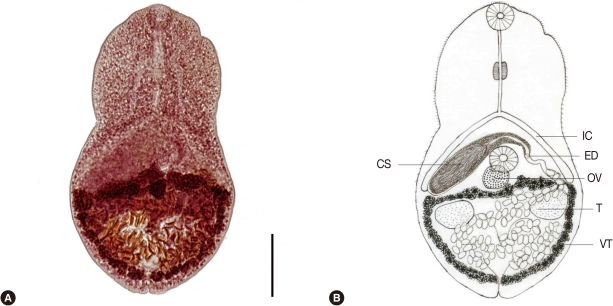Discovery of Maritrema obstipum (Digenea: Microphallidae) from Migratory Birds in Korea
Article information
Abstract
Adults of Maritrema obstipum (Digenea: Microphallidae) were found in the intestines of 4 species of migratory birds, including the sanderling (Crocethia alba), Kentish plover (Charadrius alexandrines), Mongolian plover (Charadrius mongolus), and red-necked stint (Calidris ruficollis), collected from Yubu Island, Chungcheongnam-do, Korea. The worms of were 451×265 µm in size, and were easily identifiable as Maritrema species by the presence of the cirrus sac, and the ring-like distribution of the vitellaria. More specifically, the ejaculatory duct curved posteromedially, and the 2 parts of vitelline follicles were found to be distinct at the posterior end. The eggs were brown-colored, and 19.8×12.3 µm in size. All these findings implicated M. obstipum as the pertinent species of the worms. Beside these, adult worms of Gynaecotyla squatarolae, Parvatrema duboisi, and Acanthoparyphium sp. were also discovered. This is the first report establishing migratory birds as the natural definitive hosts for M. obstipum.
Microphallidae Ward, 1901 is a large family of small flukes found in the intestines of birds, that have consumed crustaceans [1]. In South Korea, the following 4 species have been described from crustacean hosts: Microphalloides japonicus from Helice tridens tridens, Levinseniella spp. from Macrophthalmus japonicus, Gynaecotyla squatarolae, and Microphallus koreana from Macrophthalmus dilatatus [2-5]. As for cases of human infections by microphallids, there have been only a limited number of reports on Spelotrema brevicaeca and G. squatarolae [6,7]. Last year, a 5th species of Microphallidae was discovered in an Asian shore crab, Hemigrapsus sanguineus, caught in Jebu-do, Gyeonggi-do. An experimental infection revealed adult flukes having a symmetric ribbon-like vitellarium, which feature and other overall detailed morphology identified them as a new species of Maritrema, subsequently named Maritrema jebuensis [8]. This finding established, for the first time, the presence of Maritrema sp. in South Korea. The natural definitive host of Maritrema sp., however, was not yet known in South Korea. In the present study, we discovered the adult worms of Maritrema obstipum from the intestine of migratory birds, proving them as the natural definitive hosts of M. obstipum in Korea.
In October 2010, 25 dead migratory birds, i.e., 2 sanderlings (Crocethia alba), 8 Kentish plover (Charadrius alexandrines), 6 mongolian plover (Charadriums mongolus), 8 red-necked stint (Calidris ruficollis), and 1 terek sandpiper (trigna cinereus) were collected from Yubu-do, Songnim-ri, Janghang-eup, Seocheon-gun, Chungcheongnam-do, South Korea. All of the specimens were in relatively good condition and showing no signs of decomposition, and they were transported to the laboratory for further studies. There, the birds' intestines were removed, fixed in 2% formalin and examined under stereomicroscopy. The adult worms found therein were fixed in 10% formalin, and then stained with Semichon's acetocarmine, and finally mounted in permount. Ten specimens each were measured, and the results were recorded in micrometer ranges. Species identification was conducted under optical microscopy.
From the 2 sanderlings, 122 flukes were recovered, 113 of which, on the basis of the symmetric ribbon-like vitellarium, were determined to Maritrema sp. All 8 Kentish plovers and all 6 Mongolian plovers were infected with the same species. In the red-necked stints, the infection rate was 12.5% (1/8), and in the case of 1 terek sandpiper, there were no adult worms of that species.
The followings are the morphological characters of the recovered Maritrema worms (Fig. 1). Body was linguiform, 451 (400-495) µm×265 (260-270) µm. Suckers were of approximately the same size, the oral 39×39 µm and the ventral 36×39 µm. Prepharynx was absent or, if present, very short. Intestinal ceca extended laterally along the anterior edge of the cirrus sac, almost to the lateral body wall. Genital atrium was sinistral to the ventral sucker near its edge. Cirrus sac, tapering to the prostate region, was 154 (126-178) µm long, with an ejaculatory duct curving posteromedially. The vitellarium consisted of a narrow transverse band of small follicles extending laterally on either side to the body wall, and then turning posteriorly to form a ring around the posterior portion of the body. By magnification, the 2 parts of the vitellaria were found to be distinct at the posterior end. Ovary was ovoid, posterodextral to the ventral sucker and anterior to the vitellarium, and was 49 (37-62) µm×52 (37-62) µm in size. Testes were lateral, and posterior to the anterior part of vitellaria, and indistinguishable. Eggs were brown-colored and 19.8×12.3 µm in dimensions.

(A) An adult of Maritrema obstipum recovered from the sanderling, Crocethia alba. Bar=100 µm. CS, cirrus sac; VS, ventral sucker; OV, ovary; T, testis; VT, vitellarium; IC, intestinal ceca. (B) A line drawing of the Fig. 1, the adult worm of M. obstipum. CS, cirrus sac; ED, ejaculatory duct, ventral sucker; OV, ovary; T, testis; VT, vitellarium.
The morphology of M. obstipum specimens examined in this study differed from that already reported for M. jebuensis [9]. First, in M. jebuensis, the vitellaria formed a complete ring, but in M. obstipum, the 2 parts of the vitellaria, as discovered in the present study, were distinct. Second, in M. obstipum, the sucker ratio (OS/VS) was found to be 1:1, whereas in M. jebuensis, the ventral sucker was larger than the oral sucker. Third, in the present M. obstipum species, posteromedial curving of the ejaculatory duct was evident, which had been found not the case for M. jebuensis. In light of all of these findings, the worms examined in the present study were identified as belonging to M. obstipum, not M. jebuensis.
Genera other than Maritrema were also recovered from the migratory birds, as summarized in Table 1. Adult G. squatarolae worms were found in 4 bird species, Parvatrema duboisi specimens were taken from 1 of the sanderlings. In addition, 3 Acanthoparyphium sp. worms were recovered from a Mongolian plover, though species identification was impossible due to the poor condition of those worms.
In South Korea, M. jebuensis was, as noted above, first discovered in an Asian shore crab caught in Jebu-do, Gyeonggi-do [8]. It was expected that, as migratory birds have already been identified as definitive hosts for Maritrema spp. [10], their role would be essential in South Korea as well. In fact, whereas adult Maritrema sp. worms were recovered from 4 species of birds examined in the present study, among which were the Mongolian and Kentish plovers, in which no M. jebuensis specimens were found. The absence of M. jebuensis in these birds might have reflected the geographic distance between Yubu-do, Chungcheongnam-do and Jebu-do, Gyonggi-do. In any case, a Yubu-do crab survey to establish the life cycle of M. obstipum would be necessary. Certainly, considering the discovery of human G. squatarolae infection [7], surveys on Maritrema spp. infection, among the residents of Yubu-do, would also be needed.
In a previous study, the ruddy turnstone, Arenaria interpres interpres, from the seashore of Gunsan-si, Jeollabuk-do was proven to be a definitive host for G. squatarolae [11]. In the present study, in fact, adult G. squatarolae worms were also recovered from some species of migratory birds, particularly the terek sandpiper, Kentish plover, and Mongolian plover, thereby establishing them as additional definitive hosts for G. squatarolae. A survey on metacercariae of G. squatarolae revealed their presence in crabs, especially M. japonicus, from the western coastal areas of South Korea [12]. Accordingly, it has been suggested that migratory birds are the sources of G. squatarolae infection in those areas. In the present study, worms belonging to the genus Acanthoparyphium were discovered in the intestines of Mongolian plovers, but as above-noted, species identification was impossible. Further studies on this genus are required, particularly as Acanthoparyphium tyosenense has been established as a human-infecting trematode in South Korea [13].
In South Korea, a total of 19 species of intestinal trematodes, including 12 from the family Heterophyidae, had been reported in humans as of 2002 [14]. Seince then, an additional 3 species, specifically Acanthotrema felis, G. squatarolae, and Haplorchis pumilio, have been added to that list [7,15]. Even though migratory birds are known to play a pivotal role in transmission of parasitic diseases, especially those caused by intestinal trematodes, there have been few reports on such birds in South Korea. The oystercatcher, Haematopus ostralegus, has been shown to be a natural definitive host of Gymnophalloides seoi [16]. Moreover, as noted above, adult G. squatarolae worms were discovered in the intestine of a ruddy turnstone [11], and recently, adult Parvatrema duboisi and Parvatrema homoeotecnum worms were recovered from a great knot and Mongolian plovers [17]. More intestinal flukes, however, have yet to be matched with their definitive hosts. Clearly, further investigation into the migratory birds of South Korea is required.
